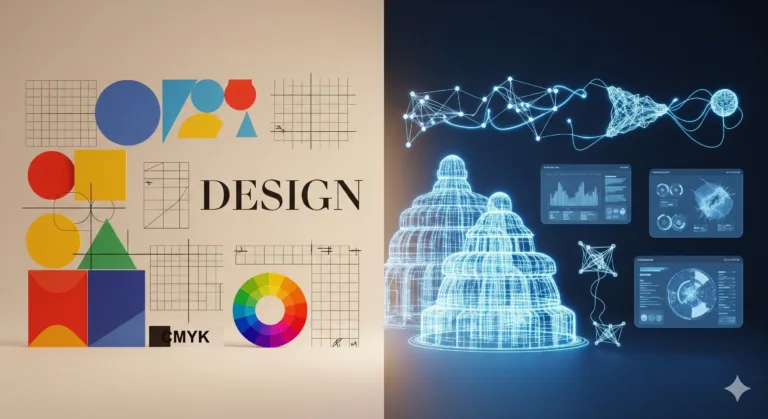Unlock Your Message: The Power of Design Purpose
Have you ever looked at a beautifully designed piece – a logo, a website, or an advertisement – and instantly understood its message, feeling a clear connection? This isn’t just about aesthetics; it’s about the conscious application of Design Purpose. For beginners in visual communication, understanding the “why” behind every design decision is the most powerful tool you can acquire. It transforms your work from merely looking good to truly communicating, influencing, and achieving specific goals.
In a world saturated with visuals, from social media feeds to product packaging, every element competes for attention. Without a clear Design Purpose, your creations risk becoming just another piece of noise, failing to resonate or make an impact. This fundamental principle ensures that every line, color, font, and layout choice serves a deliberate objective, guiding your audience and delivering your message with precision. It’s the cornerstone of effective visual communication and the secret to creating truly meaningful visuals.
What Exactly is Design Purpose?
At its core, Design Purpose is the fundamental reason a design exists. It’s the clear, defined objective that a visual piece aims to achieve. It goes beyond simply making something look appealing; it asks: “What is this design supposed to do? What problem does it solve? What message does it convey? What action should the audience take?”
Imagine a road sign. Its purpose is to provide clear, immediate information to drivers, ensuring safety and direction. Every aspect of that sign – its colors, typography, size, and placement – is meticulously designed to serve that single, vital purpose. If the sign is confusing or hard to read, it fails its purpose, regardless of how “artistic” it might look.
Similarly, a brand logo’s purpose is to create instant recognition and convey the brand’s essence. A marketing flyer’s purpose is to inform and persuade. A website’s purpose might be to sell a product or provide information. Understanding this “why” before you even begin designing is what defines intentional design. It ensures that every creative choice you make is a step towards fulfilling that objective, making your work not just beautiful, but highly effective.
Why Understanding Design Purpose is Essential for Beginners
For aspiring designers, grasping Design Purpose is paramount because it provides a roadmap for your entire creative process. It shifts your focus from simply executing a task to strategically solving a problem. This understanding is key to:
- Achieving Clarity: When you know the purpose, you can strip away unnecessary elements and focus on what truly matters, leading to clean, unambiguous designs.
- Guiding Decisions: Every choice about color, font, image, or layout can be measured against its contribution to the overall purpose. This simplifies decision-making and ensures consistency.
- Creating Impact: Designs with a clear purpose are more likely to resonate with their audience, evoke the desired emotion, and drive the intended action. They stand out because they are meaningful.
- Building Confidence: Knowing the “why” behind your work empowers you to articulate your design choices, defend your decisions, and confidently present your solutions.
- Problem-Solving: Design is inherently about solving problems. A defined purpose gives you the problem to solve and a clear metric for success.
Without a defined Design Purpose, your work becomes arbitrary, relying on fleeting trends or personal preferences rather than strategic communication. It’s the difference between merely arranging elements and crafting a powerful, persuasive message clarity.
The E.E.T.A. Method: Embodying Purpose in Your Design Process
To truly integrate Design Purpose into your work, you can apply the E.E.T.A. method. This framework helps you, the designer, embody the purpose of your work through your own approach, ensuring that your creations are not just visually appealing, but deeply meaningful and effective.
Experience: Broaden Your Understanding of User Needs
Your ability to infuse purpose into design begins with your own experiences and your capacity to understand the experiences of others. This means actively seeking out and empathizing with your target audience. The more you understand their needs, desires, and challenges, the better you can design solutions that serve a real purpose.
- Practical Application: Before starting a project, conduct brief “user interviews” (even informal ones with friends or family who match your target audience). Ask about their frustrations, what they like, and how they interact with similar products or messages. This direct experience informs your Design Purpose.
- Imaginary Example: If designing a healthy food app, spend time observing how people grocery shop, what motivates their food choices, or what challenges they face in meal planning. This “experience” helps define the app’s core purpose: to simplify healthy eating.
Expertise: Master the Tools and Principles to Serve the Purpose
Expertise in design isn’t just about knowing software; it’s about mastering the principles and tools so that they become extensions of your will to achieve a specific purpose. When you’re proficient, you can choose the right technique or visual element not because it’s trendy, but because it best serves the design’s objective. Your expertise allows you to execute the Design Purpose flawlessly.
- Practical Application: Dedicate regular time to practicing fundamental principles like hierarchy, contrast, and typography. The more fluent you become, the more effortlessly you can apply them to achieve a specific Design Purpose.
- Imaginary Example: To design a clear “emergency exit” sign, your expertise in typography allows you to select a highly legible font and your understanding of color theory helps you choose a high-contrast palette (e.g., green and white) that serves the purpose of immediate readability in a crisis.
Transparency: Clearly Communicate the “Why” Behind Your Choices
Transparency in design means being open and clear about the rationale behind your decisions. When you present your work, explain the Design Purpose and how each element contributes to it. This builds trust and demonstrates your strategic thinking, making your clients or collaborators understand that your choices are intentional, not arbitrary. It’s about showing your work’s value beyond its surface appearance.
- Practical Application: For every project in your portfolio, include a brief case study explaining the original problem, your Design Purpose, and how your final solution addresses it. This demonstrates your clear thinking.
- Imaginary Example: When presenting a logo, don’t just show the final image. Explain: “The purpose of this logo is to convey trust and innovation for a tech startup. We chose a geometric shape for stability (Purpose: Trust) and a vibrant blue accent color (Purpose: Innovation) to stand out in the market.”
Authority: Own Your Design Decisions Rooted in Purpose
Authority in design comes from confidence in your knowledge and the ability to articulate your choices. When you understand and embody Design Purpose, you gain the authority to make strong recommendations and guide your projects effectively. You can confidently explain why a certain approach is best because it is rooted in a clear objective, not just personal preference. This builds respect for your expertise.
- Practical Application: When discussing revisions with a client, refer back to the agreed-upon Design Purpose. Frame your arguments around how a proposed change might detract from or enhance that core objective.
- Imaginary Example: If a client wants to add a distracting element to a clean, minimalist website, you can confidently explain: “Adding that element would detract from our primary Design Purpose, which is to provide a seamless, focused user experience for purchasing. It would introduce visual noise and make the main call to action less effective.”
Practical Applications: Infusing Purpose into Your Designs
Understanding Design Purpose isn’t just theory; it’s a practical framework for every project. Let’s explore how to apply it.
Designing a Social Media Post with Purpose
Imagine you’re creating an Instagram post for a local bakery.
Your Design Purpose might be: “To entice followers to visit the bakery this weekend by showcasing a new, delicious pastry.”
- Visuals: A high-quality, close-up photo of the pastry (enticement).
- Text: A short, catchy headline like “Weekend Treat Alert!” (attention-grabbing), followed by “Freshly baked croissants available Sat & Sun!” (key information, enticing).
- Call to Action: “Visit Us This Weekend!” in a contrasting, easy-to-read color. Your location and hours are clearly visible.

Every element is chosen to serve the purpose of driving foot traffic, making it an impactful graphic.
Crafting a Flyer with Purpose
Consider a flyer for a community charity run.
Your Design Purpose: “To inform local residents about the charity run and encourage sign-ups to raise funds for a cause.”
- Headline: “Run for a Cause!” (clear message, inspiring). Large, bold font.
- Imagery: A photo of people running happily, or a symbolic graphic of community and support (evoking emotion, connecting to cause).
- Key Information: Date, time, location, and cause prominently displayed using clear headings and bullet points.
- Call to Action: A large, distinct button or section: “Sign Up Today!” with a website link.
- Layout: Use clear sections and ample white space to ensure readability and guide the eye from the event details to the sign-up information, demonstrating a strong design strategy.
Creating a Logo with Purpose
Think about designing a logo for a new, sustainable coffee brand.
Your Design Purpose: “To create a memorable and trustworthy visual identity that communicates natural, ethical, and high-quality coffee.”
- Shape: Perhaps a circular shape for unity and completeness, or an organic, leaf-like element to represent natural and sustainable.
- Color Palette: Earthy greens and browns for natural and ethical, perhaps a warm, inviting coffee-bean brown for quality.
- Typography: A clean, friendly sans-serif font for approachability and modernity, or a slightly rustic serif for authenticity.
- Symbol: A subtle coffee bean integrated with a leaf or a simple, abstract representation of growth.
Every choice, from the overall design strategy to the smallest detail, is meticulously aligned with the brand’s purpose.
Common Pitfalls When Overlooking Design Purpose
Even with good intentions, designers can sometimes overlook their core purpose, leading to common mistakes:
- Problem: Designs that are “pretty” but ineffective.
A designer creates a visually stunning poster, but the event details are tiny, or the call to action is hidden. It looks artistic but fails to communicate.Solution: Always ask: “Does this aesthetic choice serve the design’s ultimate goal?” Prioritize function and message clarity over pure decoration.
- Problem: Confusing or generic messaging.
A social media ad is visually appealing but doesn’t clearly state what is being offered or why the audience should care. It blends into the feed without conveying value.Solution: Before starting, articulate the single most important message. Ensure every element reinforces that message, eliminating anything that detracts from it.
- Problem: Lack of consistent visual identity.
A brand’s various marketing materials look disconnected because each piece was designed without a unifying purpose or overarching strategy.Solution: Establish a clear Design Purpose for the entire brand first. Then, ensure each individual piece aligns with that larger purpose, leading to cohesive and recognizable impactful graphics.
Your Action Plan for Mastering Design Purpose
Integrating Design Purpose into your workflow is a continuous practice. Here’s a plan to help you start:
- Today: Define the “Why.”
For your next small project (even a practice one), write down its single most important objective before you touch any design software. Example: “Create a social media graphic to announce a discount and drive website clicks.”
- This Week: Analyze with Purpose.
Pick three designs you encounter (an ad, a website, a package). For each, try to guess its primary Design Purpose. Then, analyze how effectively its visual elements (colors, fonts, layout) contribute to that purpose. Where does it succeed or fail?
- This Month: Design with Intention.
Choose a personal project (e.g., redesign a local coffee shop’s menu). First, clearly define its Design Purpose. Then, make every single design decision (font, color, layout) with that purpose in mind. Be ready to explain “why” you made each choice based on its purpose.
- Next 3 Months: Seek Purpose-Driven Feedback.
When you share your work, don’t just ask “Does this look good?” Instead, ask: “Does this design clearly convey [your defined purpose]? Does it make you want to [desired action]?” Use this feedback to refine your ability to design with a clear objective. Focus on how your designs achieve their purpose, leading to truly impactful graphics.
Frequently Asked Questions about Design Purpose
Q: Is Design Purpose the same as “brand message”?
A: Brand message is a core part of the purpose, but Design Purpose is broader. It encompasses the specific goal of a *particular* design piece (e.g., a single ad, a specific webpage) within the larger brand context.
Q: How can I define the purpose if the client isn’t clear?
A: This is common! Ask probing questions: “What do you want users to *do* after seeing this? What feeling should it evoke? What problem are we solving for your audience?” Your role is to help uncover and clarify the true Design Purpose.
Q: Can a design have multiple purposes?
A: While a design might serve several functions, it’s best to identify one primary, overarching Design Purpose. Secondary purposes should support the main one without creating visual clutter or conflicting messages. Prioritize for clear message clarity.
Conclusion: Designing with Intentional Impact
You’ve now taken a crucial step towards mastering Design Purpose: Crafting Meaningful Visuals. You understand that design is far more than just aesthetics; it’s a powerful tool for communication, influence, and problem-solving. By embracing the “why” behind every creative choice, you elevate your work from mere decoration to strategic communication.
Remember that the E.E.T.A. method (Experience, Expertise, Transparency, Authority) helps you embody this purpose as a designer. By constantly seeking to understand your audience, honing your craft, clearly articulating your decisions, and confidently owning your solutions, you create designs that are not only beautiful but also deeply effective and impactful. This intentional approach is the hallmark of professional design strategy.
So, the next time you approach a blank canvas, start by defining your Design Purpose. Let it be your compass, guiding every decision, from color palettes and typography to layout and imagery. With consistent practice, you’ll find yourself creating designs that resonate, connect, and truly make a difference. Your journey into intentional and meaningful design has just truly begun. Keep creating with purpose!
Recommended Reading:
– Visual Storytelling: Design That Speaks to Your Audience – Discover how to use visual elements to communicate ideas, evoke emotions, and tell a compelling narrative that resonates with your audience, a key aspect of fulfilling your design purpose.
External Reference:
– Nielsen Norman Group: Usability 101 – Explore fundamental principles of usability, which are directly tied to ensuring your design’s purpose is effectively achieved for users.



